How Much Beef Will You Get From a Cow: Breakdown
Looking for a breakdown of how much beef you will get from a cow? Maybe you are interested in growing your own beef steer. Or maybe you’re looking into buying a whole animal from a local farmer.
Either way, you should know how much beef you will get from a cow so that you can plan accordingly.
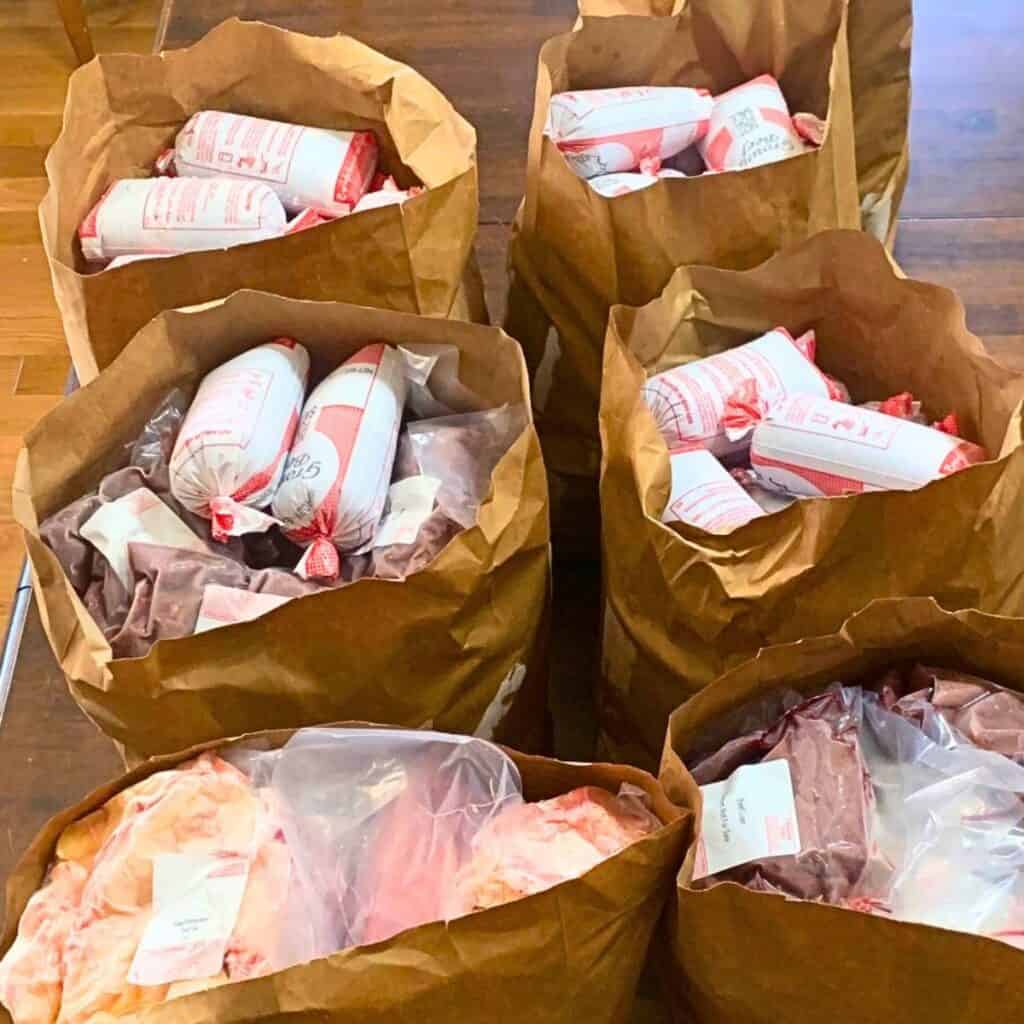
Maybe you’re considering raising and harvesting your own beef cow to cut down on your grocery bill. Or maybe you want to buy grass-fed beef from your local farmer. But you don’t know how much beef you’ll get from a whole cow.
If you have questions about how much and what type of meat you’ll get from an average cow, you’ve come to the right place. It’s a normal question. Especially if this is your first time getting a whole cow’s worth of beef all at once.
Two big questions we had when we started buying grass-fed beef direct from a local farmer were, “How much beef would a whole cow produce?” And “How many cubic feet of freezer space will I need?”
In short, dairy cow breeds, females, and young cows don’t produce as much meat as beef cows and mature bulls. So the answer will vary depending on where your beef is coming from.
How Much Beef Do You Get From a Cow?
How much beef you get from a cow will vary based on the cow’s breed, genetic variability within the breed, age, frame size, gender, and diet. A small beef steer with a live weight of 1,000 pounds and hanging weight of 500 pounds will provide roughly 250 pounds of meat.
We took our 1-year-old dairy steer (a Holstein) to our local butcher when Plan A failed. Meaning our 2-year-old Jersey/Angus steer refused to get onto the livestock trailer.
The next month, we took our 2-year-old Jersey/Angus steer to the butcher.
I’m sharing how much beef we got back from both steers. Including the totals for all the popular cuts of beef!
How much beef do you get from a dairy cow steer?
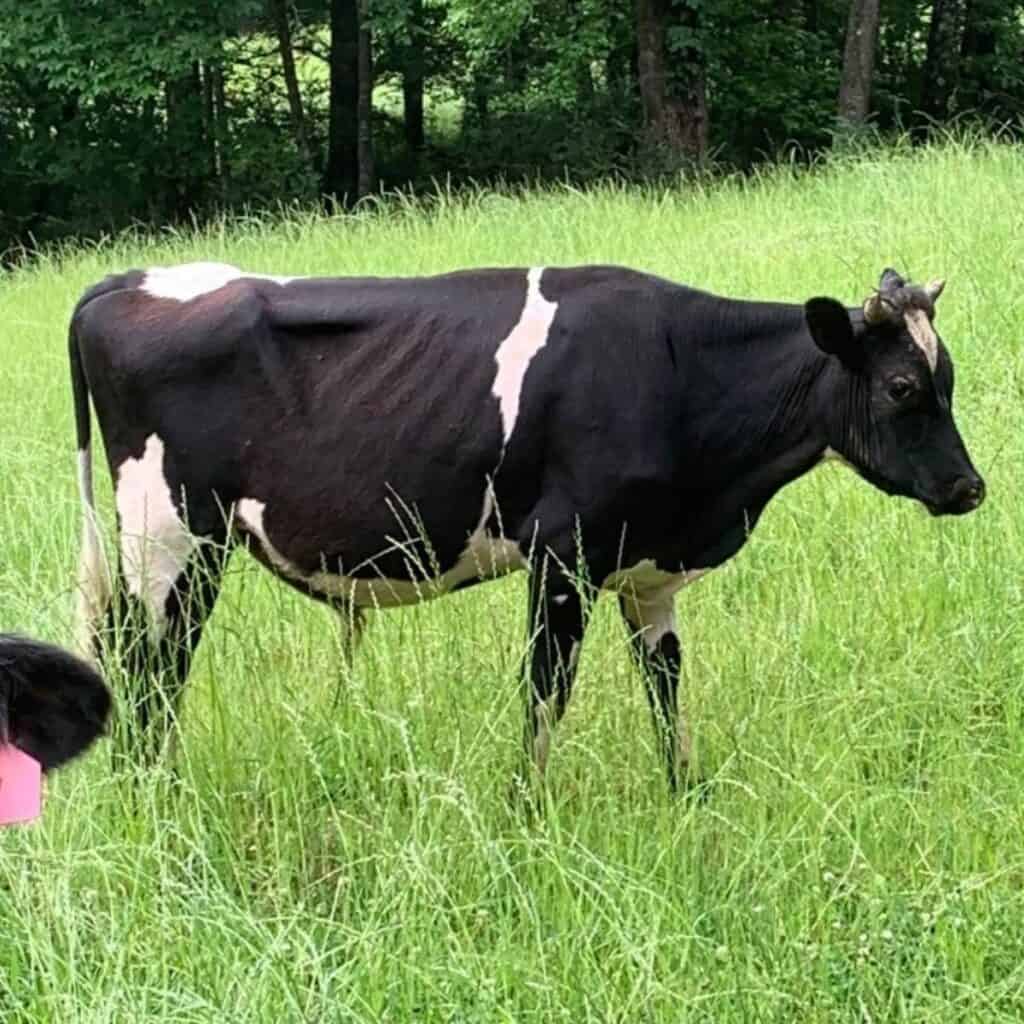
A dairy cow steer produces less beef than a beef cow steer, and a small steer weighing 800 pounds (363 kg) will provide roughly 125 pounds (57 kg) of useable meat. Specific variables include the cow’s breed, genetic variability within the breed, age, size, diet, and other factors.
We took our 1-year-old Holstein dairy cow steer to the butcher, as mentioned above, when the steer we had planned on taking refused to get onto the livestock trailer.
Our dairy cow steer had a live weight of roughly 500 pounds (227 kg) when we took him to the butcher. His hanging weight was exactly 256 pounds (116 kg).
After the butcher got done processing, we got back exactly 80 pounds of meat and it was all ground beef. There wasn’t even enough meat for individual cuts of steak because he was such a skinny and young dairy cow steer.
At my butcher, we fill out a beef cut sheet request form where we can make special customer requests for the beef they return to us. This includes filling out how many steaks we want in a package and any custom cuts.
I remember when the butcher called me back after we dropped off our steer. The conversation went something like this.
“Um, we’re calling you because if you want any steaks, there’s not going to be hardly any meat on them. Do you just want us to do ground beef for everything that we can?” I said, “Sure.”
Several days later, I went to pick up the order. The butcher said that he was surprised that he was able to get 80 pounds (36 kg) of ground beef from that little steer! I was equally surprised.
How much beef do you get from a beef cow steer?
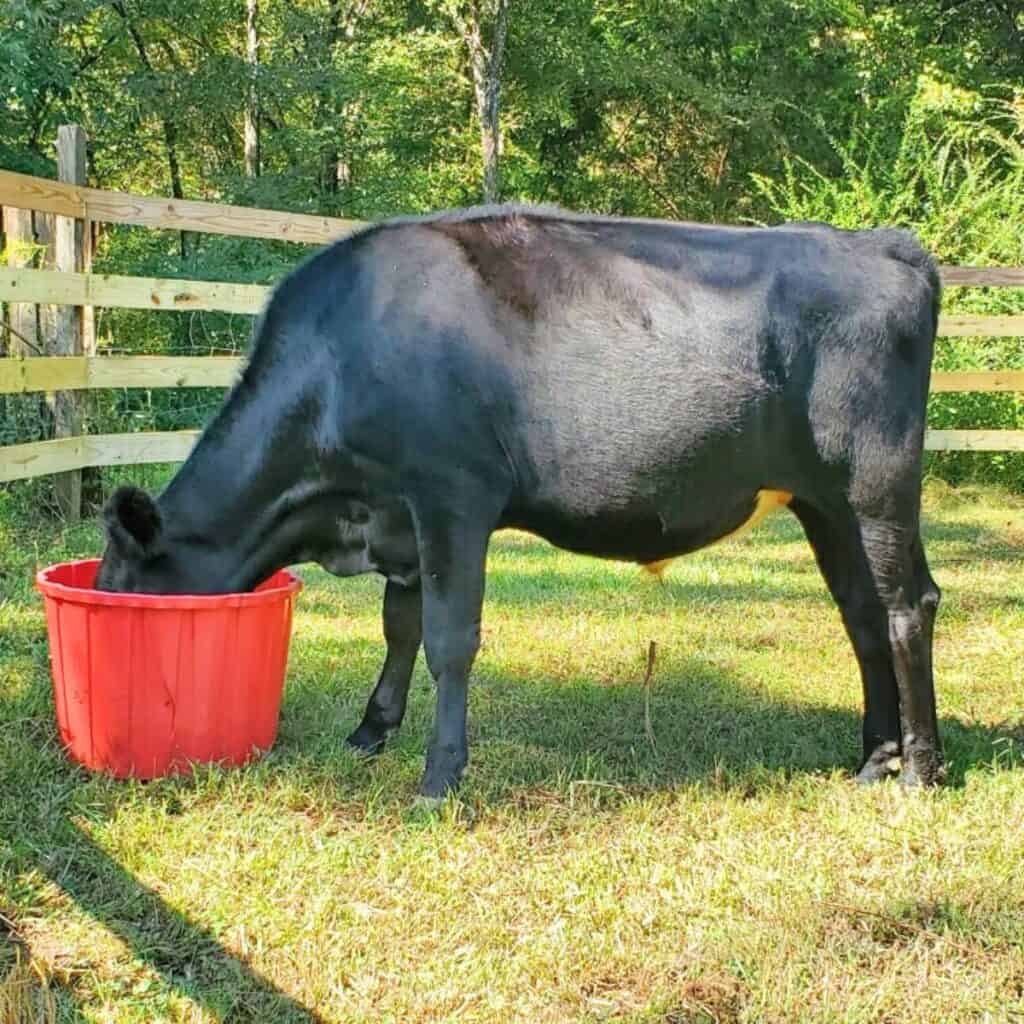
How much beef you get from a beef cow steer will vary based on the cow’s breed, genetic variability within the breed, age, and other factors. A beef steer weighing 1,000 pounds (454 kg) with a hanging weight of 500 pounds (227 kg) will produce up to 330 pounds (150 kg) of meat.
As mentioned previously, our 2-year-old Jersey/Angus steer was scheduled to go to the butcher, but missed his appointment due to his stubbornness. Fortunately, the butcher had a cancellation and we were able to take the steer the very next month.
When we took our 2-year-old Jersey/Angus steer to the butcher, his live weight was roughly 900 pounds (408.2 kg). He was half dairy cow breed and half beef cow breed, but on the skinny side.
His hanging weight was exactly 455 pounds (206 kg), and we got back 260 pounds (118 kg) of beef, soup bones, fat, and some internal organs.
Beef cuts from a cow:
I recorded everything and tallied it up. Here’s the breakdown:
Ground beef – 112 pounds (51 kg)
Roasts – 57.70 pounds (26 kg)
We got back chuck roast, beef brisket, rump roast, shoulder roast, sirloin roast, and the tongue. (After roasting the tongue as you would any other roast, simply de-skin the tongue. It’s tender and delicious!)
Steaks – 26.94 pounds (12 kg)
We got back ribeye steaks, NY strip steaks, T-Bone steaks, sirloin steaks, and filet mignon.
I went on a deep dive in How Many Steaks Are In A Beef Cow? (Our Numbers!) Unless you were raised on a farm, I doubt you know just how many steaks there are. (wink wink)
Beef tips – 11.06 pounds (5 kg)
Stew meat – 10.58 pounds (5 kg)
Oxtail – 1.18 pounds (0.5 kg)
Short ribs – 11.86 pounds (5.4 kg)
Organ meats – 9.86 pounds (4.5 kg)
Fat – 2.76 pounds (1.25 kg)
Soup bones – 16.64 pounds (7.5 kg)
This 900-pound cow produced 260.58 pounds (118.2 kg) of beef, soup bones, fat, and some internal organ meats.
What is the hanging weight and packaged weight?
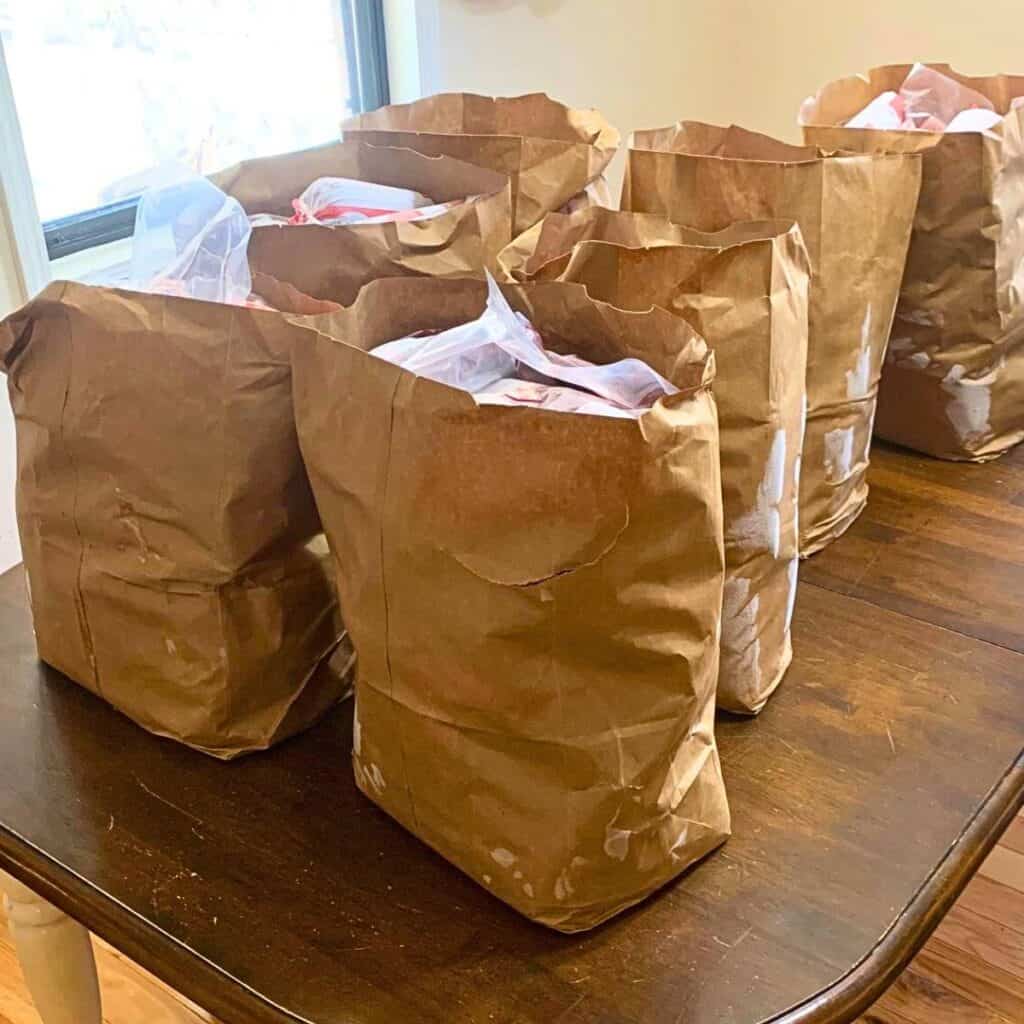
The hanging weight of the animal is the weight of the unchilled carcass after the head, tail, and feet are cut off, it’s gutted, and then the hide is removed.
The packaged weight is what’s left after blood and water loss, and removing bones and excess fat. It’s the final weight after processing when meat cuts are packaged for customers.
First-time customers are generally surprised when they purchase an entire cow from beef producers and their take-home meat is much smaller.
As the name implies, the live animal weight is the cow’s weight while it’s still alive. Then you take the cow to the butcher where the undesirables and offal (viscera) are removed. This is called the hot carcass weight.
The hot carcass weight is the weight of the carcass before it goes into the cooler to age. (It’s best to age beef carcasses for at least a week so that the flavor gets deeper and to get tender muscles.)
Moisture loss in the cooler is a result of blood draining out and water evaporation. A beef carcass consists of 70 to 75 percent water.
According to the University of Wisconsin, a carcass can lose 2 to 5 percent of its initial weight in the first 24 hours!
Steps first-time buyers should take when ordering a beef cow.
If this is your first time buying a quarter, half, or whole beef cow from a local farmer or butcher, you should tour the farm where the cows live, tour the butcher shop, and evaluate your available freezer space.
1. Tour local farms.
Unless you’re raising a beef steer or cow yourself, first-time buyers should tour local farms that raise beef cows if they are considering purchasing a quarter, half, or whole cow.
Before we moved to the farm, we would buy half of a beef cow from a local farmer who raised them (and another family would buy the other half).
I was impressed at the process the farmer used for selling his beef. We toured his amazing farm, and looked at his healthy herd of beef cows.
The pasture grass was green and lush, the cows were healthy and happy, and I got the opportunity to ask the farmer a ton of questions.
Here are some questions customers should ask the farmer:
- Can I tour your farm and see your herd of cattle? (I highly recommend getting a farm tour before you commit to purchasing anything.)
- Do you vaccinate or otherwise medicate your cows?
- Are your cows 100% grass-fed, or do you supplement with grain?
- If you supplement with grain, is it non-GMO grain?
- Do you spray your pastures with anything?
- Where does the cow’s drinking water come from? (A clean spring? Pond? Fluoridated city or county water?)
- What breed of cows do you raise, and how much meat do they generally produce?
- Are your beef cows born and raised here, or do you buy calves from somewhere else? If so, where? (This question is important if getting vaccine-free and non-GMO meat is important to you.)
- When is the next time you will have beef available?
- Do you harvest and process the cows here on the farm, or do you use a local butcher? If you take the cows to a butcher, which one(s)?
Your purchasing dollars should support the farming practices that matter to you. And supporting local farmers is a great way to ensure your food security in the future!
2. Tour the butcher shop.
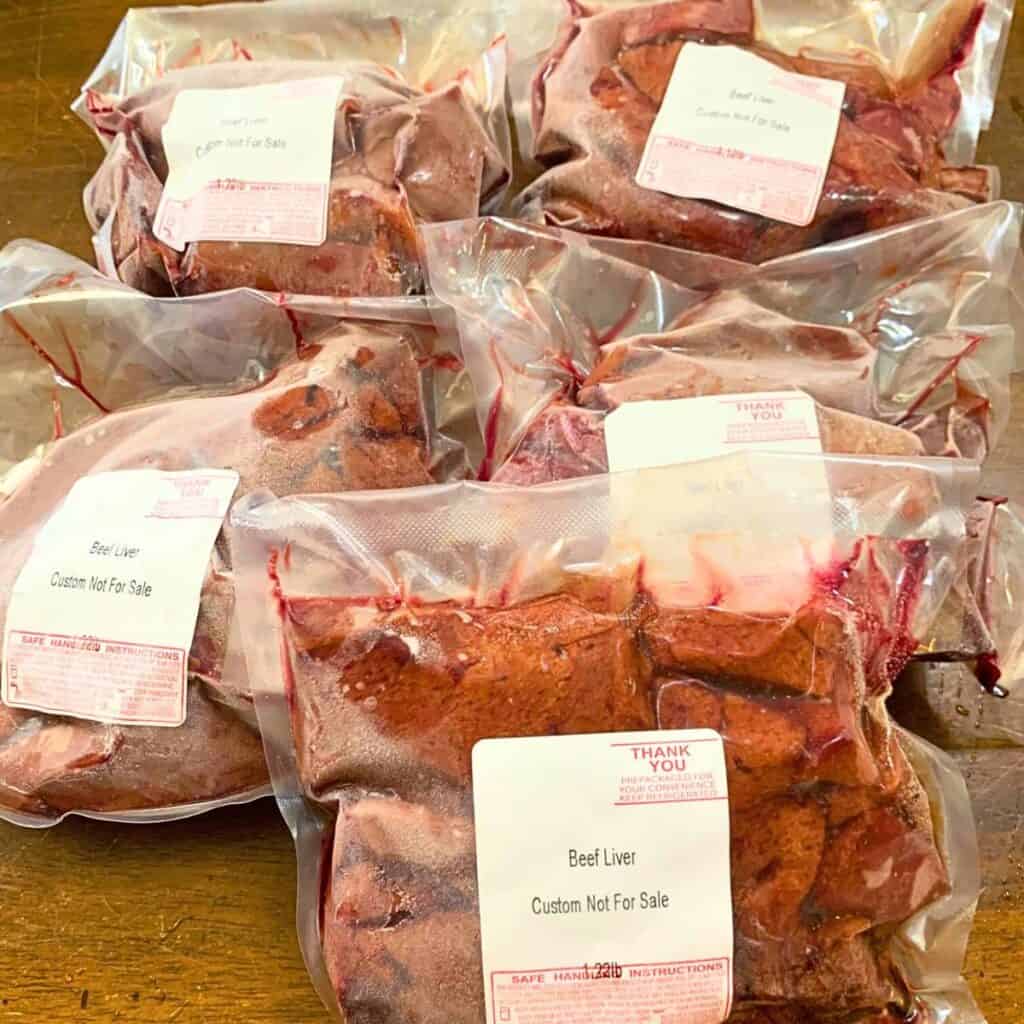
So you’ve decided that you want to buy beef in bulk from a local farmer. The next thing you should do is tour the butcher shop. You should see where the cow will be harvested and processed. In most cases, you can do your own inspection and ask questions.
When our local farmer told me which butcher he would drive the cows to on harvest day, I toured that butcher shop. I had never toured a butcher shop before, so I didn’t know what to expect.
It seemed like a good idea to make sure that the butcher shop was clean and tidy. And it was.
If this is your first time buying beef from a local butcher, I want to encourage you to learn all that you can from them. I have toured several butcher shops. I’ve never met a butcher that wasn’t nice as all get out, or that I didn’t like!
Butcher Pricing
Our butcher charges a variable “dressing” fee. This fee is based on the size of the cow, and ranges from $50 for lighter cows up to $125 for heavier cows.
Additionally, there are two sets of prices for processing.
One price per pound is for retail cuts and inspected meat (varies from $0.82 per pound up to $0.90 per pound, depending on weight).
Then they offer a cheaper price per pound for “custom cut” which means for a family’s personal consumption and not meat they intend to sell ($0.77 per pound if the hanging weight is less than 900 pounds; anything over 900 pounds is $0.90 per pound).
Here are some questions customers should ask the butcher:
- Can I take a tour of your butcher shop?
- How do you kill the cow? (Is it humane?)
- How long do you age the meat? (The answer may vary depending on the size and age of the cow. Hopefully it’s aged at least a few days. A week or longer is better. Beef flavor gets deeper and better the longer the beef ages. If dry-aged beef is important to you, ask if the butcher offers it.)
- What are the different cuts of meat that you offer? (If it’s important to you, ask if they will save the beef fat, soup bones, internal organs, tongue, and oxtail. Some butchers will also save the hide for you so that you can either tan the hide yourself or take it to a tannery. Of course, butchers will have their own way of doing things. They may be limited by state and local laws.)
- What is your pricing?
- Do you vacuum-seal your cuts?
- How long do customers have to pick up their order after you call to tell them that their order is ready for pickup? (My butcher will hold our order for at most an extra 10 days before they sell it to someone else. I recommend leaving your beef order at the butcher in their freezer for at least a couple of days. That way your meat will freeze! Have you ever tried to put a whole lot of anything into a freezer? It takes FOREVER for meat to freeze. It may even break your freezer…ahem.)
3. Evaluate your available freezer space, and plan accordingly.
Before you reserve and order a bulk amount of meat, you should evaluate your available freezer space. You won’t have enough freezer space for a whole cow’s worth of beef unless you have an empty upright freezer or chest freezer.
The first time we reserved half a cow, I clearly remember waiting for an upright freezer to be delivered when our order at the butcher was ready for pickup. Because all the freezers were back-ordered for several months, I had to take a load of frozen meat to my parents’ house to store in their extra freezer.
Thank the Lord for sweet parents!
Freezer Space Requirements
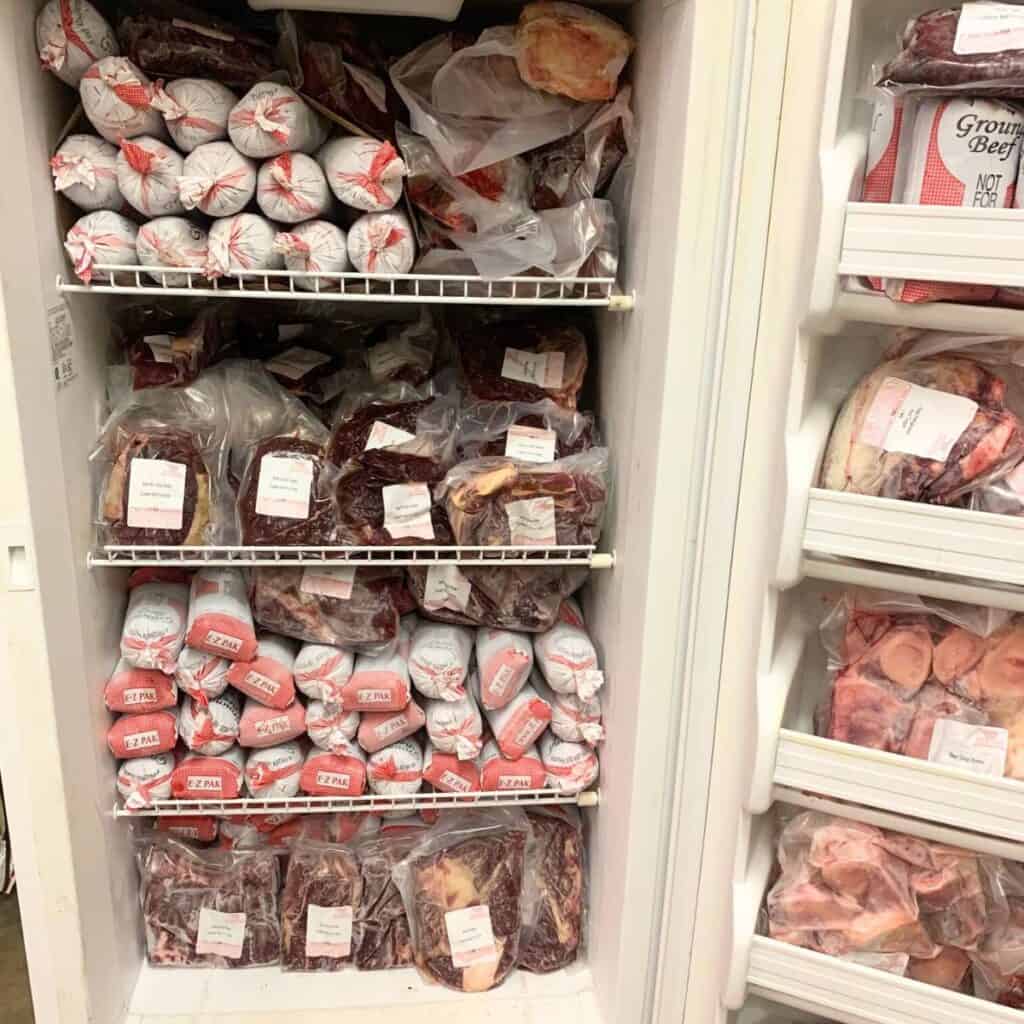
The big takeaway is to evaluate how much freezer space you have. As a general rule, plan on needing at least 1 cubic foot of freezer space per 20 pounds (9 kg) of freezer beef. Odd angle cuts will need more room because of wasted space.
For a whole cow producing 260 pounds (118 kg) of beef and bones, you will need at least 13 cubic feet of freezer space.
For a half cow producing 130 pounds (59 kg) of beef and bones, you will need at least 6.5 cubic feet of freezer space.
And for a quarter of beef producing 65 pounds (30 kg) of beef and bones, you will need at least 3.25 cubic feet of freezer space.
My goal is to have enough beef in the freezer to last an entire year. Or at least until our next harvest date.
We put all our beef into a designated beef freezer. The 260 pounds from our Jersey/Angus steer plus the 80 pounds of ground beef from our Holstein steer filled it up completely! The total take home weight was 340 pounds of beef.
Our freezer is 17 cubic feet, and the amount of beef we received filled it from the top to the bottom, including the door shelves. I recommend stocking your freezer to make it easy on yourself when you go to take it out.
And wear winter gloves when you’re stocking your freezer! Gloves with anti-skid rubber pads make it much less painful to put your groceries away.
Next Steps
Read the other posts in this series:
How Many Steaks Are In A Beef Cow? (Our Numbers!)
Understanding Beef Hanging Weight vs Packaged Weight
Sirloin tip roast vs tri tip. What’s the difference?
If you enjoyed this post and are ready to raise your own beef animal, check out the secret to raising livestock for cheap!
Then, check out my seven tips to help you on your journey so that you don’t have a breakdown whenever it’s time to harvest them for food.
Pin It For Later!
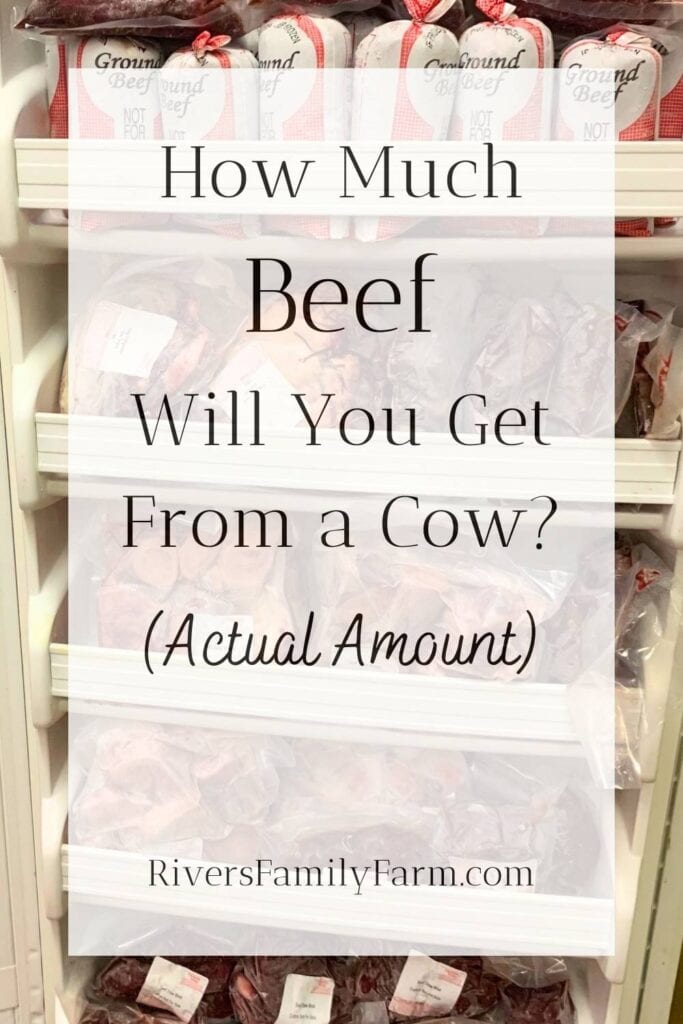
Other Related Posts
How Many Steaks Are In A Beef Cow? (Our Numbers!)

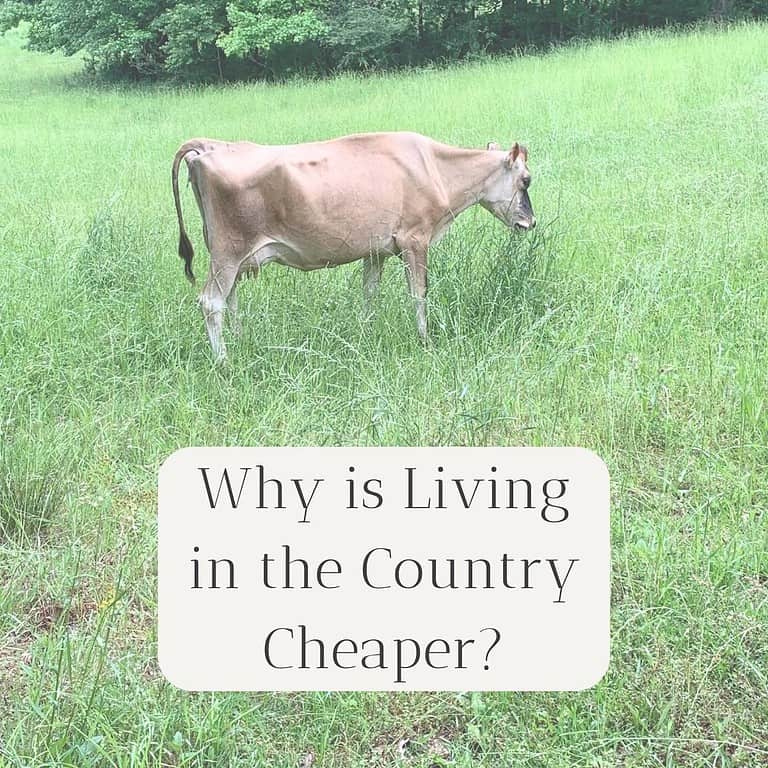
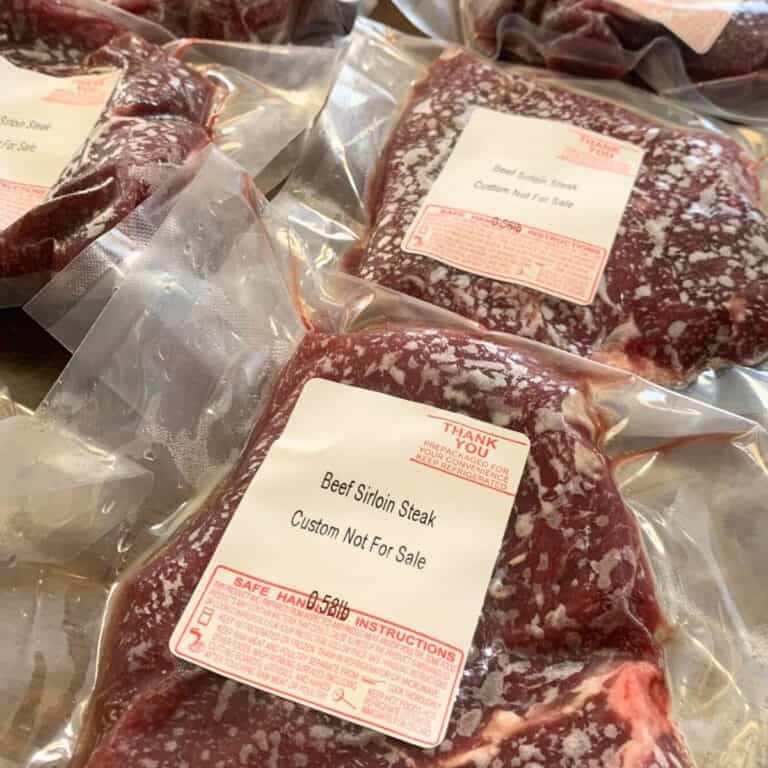
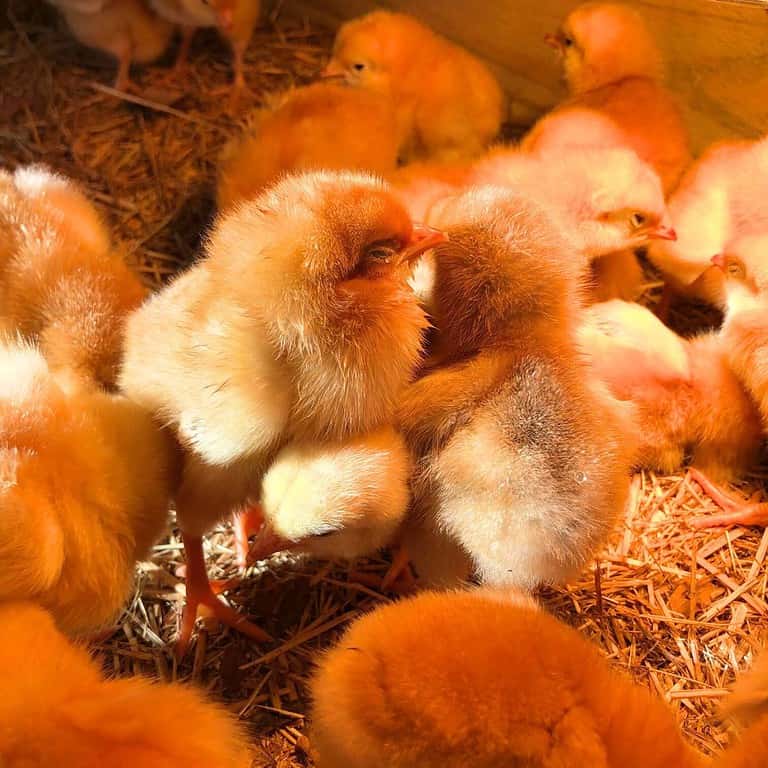
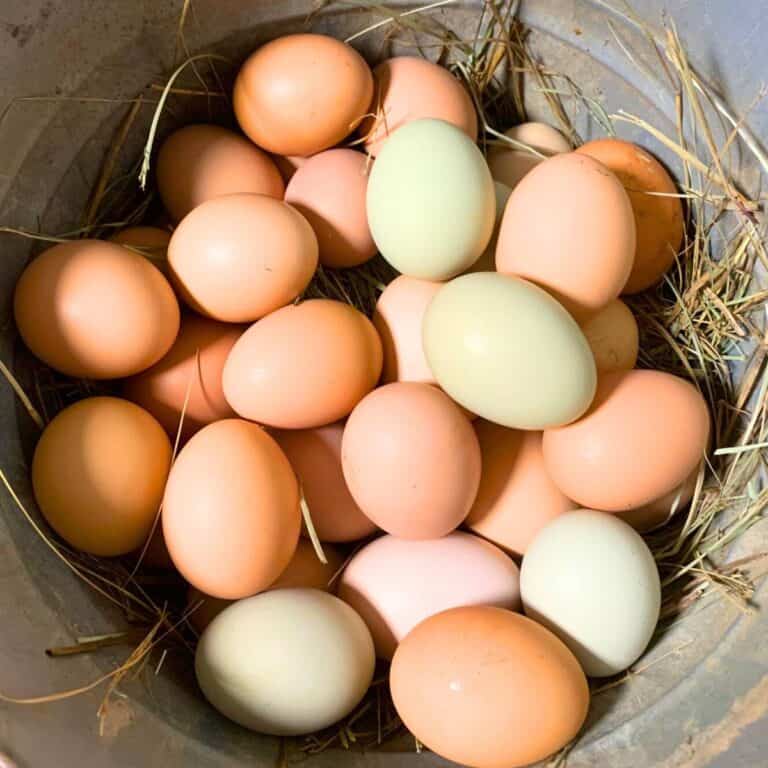

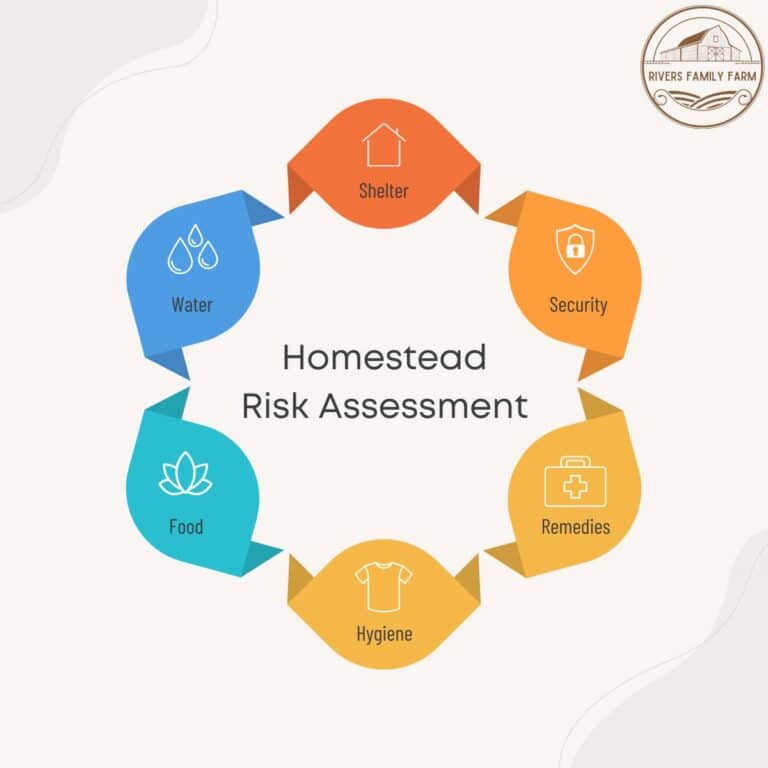
Thank you for this comprehensive post. I’ve been buying direct from farmers for years and live weight, hanging weight, and wrapped weight has confused me for years. You explained this very well. Thank you.
You’re very welcome! I was the same way!!
This post was incredibly informative and I am saving it for reference later!
Thanks and I’m glad I could help!
This article is jam packed full of info. We are looking into buying a half cow at one of our local farms. Thank you!
That’s what we did before moving to the farm, too. I’m glad you found it helpful, and you’re welcome!
Having been raised with nose-tail eating, I can tell that you missed a couple of important things. 1) neck bones 2)head for head cheese
Also, WHY did you not get the hanger steak in your steaks?
Lastly–look up cow foot stew–(Jamaican dish)
Hi Lois, I love that you were raised with nose to tail eating! I’m glad that you mentioned the bones, head, hanger steak, and cow feet. For the head and feet, my butcher does not allow us to keep them…because I’ve asked before. I was able to go to a different butcher and keep a few pig heads that we raised and harvested for head cheese, though. I just haven’t tried it with a cow head yet. There’s also a charming (in my opinion) tradition in some Native American cultures to keep deer and cow claws (feet) to create what sounds like bells on their leg wraps. (After you boil the feet, they become hollow and sound like bells when they clank together.) I’m not sure what they’re called, but it sounded so lovely when I met a lady who was wearing those traditional clothes! As for the neck bones, I was able to keep them along with the ox tail for soup bones and those are included in my calculation for soup bones that totaled almost 17 pounds. Finally, I’m not sure about the hanger steak but I’ll be sure to ask for it the next time we take a steer to the butcher! It wasn’t listed as an option on my cut butcher’s cut sheet. I’m not sure if that’s because it’s included in one of the other more popular steak cuts or not, but I’m excited to try it out! Thanks for your suggestion!!
Love, Rebekah